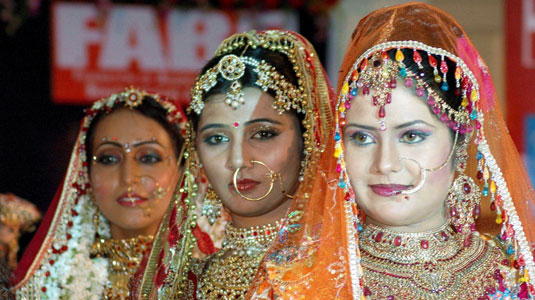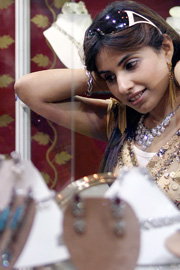Finding matrimony online in India
Setting aside centuries of tradition, young people turn to the web for marriage.

 |
| Would-be Indian brides now have more freedom than ever before in selecting a mate [EPA] |
After three years of waiting for her parents to find a husband, Anisa Tiwari, a 26- year-old marketing assistant at a New Delhi hotel, took matters into her own hands.
She registered with a matrimonial website, specified her requirements – religion, language, caste and education – and then waited to be contacted. Within a few days her email inbox was flooded with messages from prospective suitors.
“My parents’ social circle is small. I realised we were fishing in a small pond. It was better to go to a matrimonial website where there are thousands of suitable men to choose from,” said Tiwari.
Eventually, Tiwari found the man who would be her husband, Dhruv, on www.shaadi.com (‘shaadi’ means wedding), one of India’s most popular matrimonial websites.
“It is instant, convenient, and economical; you have total anonymity, you can sit at home in comfort, and it allows you to exercise your personal choice,” Tiwari told Al Jazeera.
Age-old traditions
Marriage in India has long been regarded as a ‘union’ of two families rather than two individuals, making the participation of the parents of paramount importance.
Such participation is ensured in an arranged marriage because of shared religion, caste, culture, education family background and aspirations.
Little wonder then that until recently some 95 per cent of marriages were arranged by parents and family following age-old customs.
Even the educated middle class is known to have preferred arranged marriages.
For centuries, the parents settled on a prospective bride or groom for their offspring with the help of family members, friends or marriage brokers who carried photo albums and horoscopes of eligible spouses.
Matrimonial ads
In the last few decades, if the family or broker failed to find the right match, the parents also resorted to advertising in the matrimonial sections of the Sunday newspapers.
The identification of the right person to be the spouse was followed by discreet inquiries about the potential bride or groom with their neighbours, friends and relatives.
The bride and groom came into the picture only at the very end of this process once the right spouse had been identified, his or her profession and education confirmed, family background vetted and mental illnesses and physical infirmities ruled out.
Until a few decades ago, prospective couples were not even shown photographs of each other. Meeting one another was equally out of the question.
The situation started changing after Indian independence in 1947 and then, about 20 years ago, the bride and groom started being allowed a brief meeting in the presence of relatives and the marriage went ahead only if and when the bride and groom agreed.
The rules of spouse selection and marriage have changed even further since then. These days, the parents start looking for a partner for their son or daughter only after detailed consultations with them about their preferences.
Now, couples from liberal homes can have a meal or two together before making their decision. Once engaged, they can meet, talk and get to know each other
Web-bound hopes
| Fact box |
|
Around 60 per cent of India’s 40 million internet users are below the age of 25. Matrimonial sites are the 13th most popular online activity. |
When matrimonial sites first start appearing in India, however, a few years ago, young Indians suddenly found themselves empowered.
They now had an avenue where they could take the lead in searching for someone who satisfied their parents’ expectations but also matched their own preferences and needs.
A new term – ‘planned marriages’ emerged. Arranged marriages could now be replaced by ‘planned marriages’ in which young men and women beginning to look for a spouse could fall in love outside the traditional tenets while still meeting the requirements for parental approval.
Economic and social shifts – the breakdown of the extended family structure, the women’s movement, and young Indians moving out of the parental home to seek work in other cities also contributed to the increasing popularity of matrimonial websites.
Ashish Nandy, a political psychologist and sociologist, believes that young Indians are increasingly influenced by Western ideas and yearn for of compatibility, chemistry and romance.
He said: “The younger generation wants someone with the right personality and interests, not just parents mechanically ticking off a list with caste, income, age and profession on it.”
Millions registered
 |
| Young women can browse the sites for a husband [EPA] |
There are now 100 matrimonial websites operating in India, with a projected growth rate of 120 per cent. Nearly 20 million members registered worldwide on the two leading sites alone.
“The Internet both reflects radical changes in society and is also a vehicle for social change itself,” said Dr Rita Mahajan, a consultant psychologist at the Noida Medical Centre in Delhi.
“Pre-marital relationships are still frowned on in India. The net allows Indians to meet and talk without any fear.”
These freedoms are what appealed to Nikhil Ghosh, a 29-year-old electrical engineer in Gurgaon, a township just outside Delhi.
Ghosh, a Brahmin from West Bengal, knew that any prospective bride would have to come from the same background to please his parents but he was also looking for someone who could appreciate his three passions – hiking, tennis, and Indian classical music.
“I sifted through all the possible girls on bharatmatrimony, read their profiles, checked if our interests and attitudes matched, and then I found Sonali,” he said.
“I exchanged emails with her and then we met in Delhi – all before I mentioned any of this to my parents,” said Ghosh.
Once Ghosh and Sonali decided they wanted to marry, they ‘informed’ their parents. There were no objections on either side because Sonali and Ghosh were exactly the kind of spouse their respective parents had been hoping for.
Streamlined marriages
Murugavel Janakiraman, the founder and chief executive of the Bharatmatrimony Group, believes the option of a systematic search for a life partner is what appeals to many of his registered users.
“Our sites streamline arranged marriages. Instead of a random pursuit through some distant relative, you can be systematic and get exactly the kind of person you want,” he told Al Jazeera.
Anupam Mittal, the president of People Group, which owns shaadi.com, says the internet both gives Indians much more information about a person before they meet and shortens the whole process of homing in on the right person.
“Finding a partner online means you have a much better idea of the other person’s personality by having exchanged e-mails and chatted online,” Mittal said.
The success rates of these sites are hard to gauge as many registered users may not provide information about their marriage decisions. Nevertheless, shaadi.com executives boast a rate of 50 marriages a day.
Bharatmatrimony.com claims its success rate is eight times higher.
Now that these general, ‘umbrella’ sites have become the method of choice for young urban Indians in search of a suitable partner, a string of specialised sites has sprung up catering for specific professions.
One site, www.bposhaadi.com, caters exclusively to call centre workers (who work night shifts because of the time difference between the US and UK), and is India’s first niche matrimonial site.
Pahwa, an advertising professional and the CEO of bposhaadi.com, is delighted with the success of his specialised matrimonial services. His other sites cater for engineers, government employees, multi-national company employees, thirty-somethings, and people with disabilities.
“If a husband goes to work at night and sleeps during the day, when does he spend time with his wife? When do they socialise?” he said.
“It makes sense for call centre workers to meet other call centre workers because they understand the pressures,” he added.
Negative effects
However, not all online matrimonial experiences have happy endings.
Without the security net of family and relatives who can vouch for the potential spouse, the danger of online matrimony is that someone’s profile could be a tissue of lies.
Cases have been reported of married men pretending to be single, of people posting someone else’s photograph, of people lying about their age, jobs, and qualifications.
Seema Gupta, a New Delhi call centre worker who met her husband through shaadi.com, believes that risk is inherent in all arranged marriages.
“My friend went the traditional route and was introduced to someone through her uncle. The boy said he was a computer scientist but turned out to be a carpenter,” she said.
“You just have to make some basic background checks before you commit yourself.”